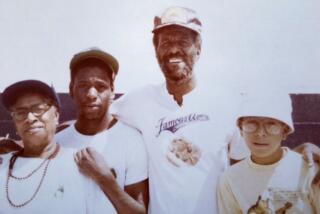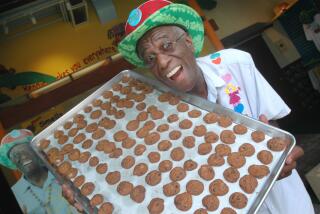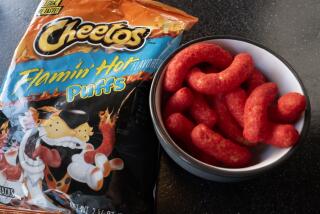Firms Tell How Soft-Cookie Sales Crumbled After a Heated Battle
- Share via
Brian Carter--the man in charge of buying cookies for Lucky Stores in Southern California--found himself caught in the cross fire of the cookie wars.
Sales representatives from the major cookie makers dangled discounts, displays and promotions before him to get the Lucky supermarket chain to carry the hottest product to come out of the cookie ovens in a long time: the chewy in the middle, crunchy on the outside soft cookie. “They were pushing them very hard,” he said.
“Initially, they did very well and sold very fast,” said Carter of the soft cookies. But, as time passed, sales started to decline. “We got stuck with a lot of inventory,” he recalls of a particular promotion that left much to be desired.
For that matter, the soft cookie has also left something to be desired. After waging a five-year war that shook up a sleepy industry and featured multimillion-dollar advertising campaigns, allegations of corporate spying, price-cutting, free samples and cents-off coupons, the major cookie combatants--Nabisco, Procter & Gamble, Keebler and Frito-Lay--have very little to show for their very expensive efforts.
After an initial burst of sales, the public seems to have lost its appetite. “(Soft cookies) tasted like raw dough,” said snack food analyst Lisbeth Echeandia of American Consulting.
Industry experts had predicted that soft cookies could capture up to 35% of the $3 billion that Americans spend annually on packaged cookies. Instead, soft cookies peaked in 1985 with about $450 million in sales, and fell to about $300 million last year--about 10% of the market, according to Snack Food magazine.
And instead of increasing the size of the total cookie market, soft cookies ate away at the sales of existing products, analysts say. Per-capita cookie consumption in the United States, in fact, has declined to an estimated 9.79 pounds per person last year from 10.05 pounds in 1984. Consumption is expected to decline even further this year.
Frito-Lay and P&G;, which sought to seize a great chunk of the market with their soft cookies, were beaten back by established industry leaders Nabisco and Keebler, but only after costly defensive tactics.
“Five years later and a couple of hundred of millions in losses, we’re back to where we were,” said Hugh S. Zurkuhlen, an analyst with Salomon Bros. “The consumer got a cheaper cookie and a few more stomach aches.”
Soft cookies also triggered severe financial headaches at cookie makers:
- Frito-Lay, whose Grandma’s cookies were the first soft cookie to be tested in the marketplace, took a $16-million charge in 1986 after it decided to pull its soft cookies from supermarkets and focus on convenience stores.
- Nabisco, the largest cookie maker, saw profit margins take a beating over the heavy promotion of its Almost Home brand soft cookie.
- P&G;, maker of Duncan Hines soft cookies, took an $800-million charge in the fourth quarter last month due to a companywide restructuring and a decision to drastically cut back on soft-cookie production. Analysts estimated that half of the $800 million was related to cutting back cookie production.
Based on P&G;’s cutback in cookie production, H. John Greeniaus, Nabisco Brands’ new president, last month reportedly declared his company the victor.
But, said a Midwestern cookie baker: “I don’t think anybody won. The stockholders of the various corporations are probably the biggest losers.”
The soft cookies came to market as cookie and snack executives set their sights on the millions of aging baby boomers who yearned for the taste of warm and chewy soft cookies but had little time for baking. Freshly baked soft cookies were selling like hot cakes at cookie emporiums such as Mrs. Fields’ and Famous Amos.
But industry leaders Nabisco and Keebler hesitated rolling out any new products for fear of cannibalizing existing sales.
Newcomers Shook Up Industry
It took two newcomers to the cookie business--Frito-Lay and P&G--to; start the ball rolling. “It was a sleepy oligopoly,” said Zurkuhlen of the industry before soft cookies came along. P&G; and Frito-Lay figured, said Zurkuhlen, that “we can come in there and shake things up, and we’ll come out with market share.”
Frito-Lay got started first in 1980 by buying Grandma’s, a regional cookie baker in Oregon. Grandma’s soft, moist cookies were test-marketed in the Kansas City area in May, 1982, and the brand soon scooped up 20% of total cookie sales in the area.
Then P&G;, which had reportedly spent $30 million on developing its own soft cookies, tested consumers’ response to its Duncan Hines cookies in the same area in January, 1983, capturing up to 35% of cookie sales.
Faced with the prospect of losing out to newcomers, Nabisco and Keebler fought back. Nabisco--maker of Oreos, the industry’s top-selling cookie--came out with its Almost Home brand in August, 1983, and the Keebler elves baked up Soft Batch in March, 1984.
The soft cookies were backed by large advertising and promotion budgets. Keebler launched the largest advertising campaign in its history; Duncan Hines cookie samples were mailed to consumers in numerous cities across the nation--500,000 homes in the Kansas City area alone.
The cookie war spread from the supermarkets to the courts in 1984, when P&G; filed suit against Nabisco, Keebler and Frito-Lay alleging that the companies had stolen its patented soft-cookie technology. In its suit, P&G; claimed:
- A Keebler employee chartered a small airplane to take aerial photos of a P&G; soft-cookie plant under construction in Tennessee.
- A Frito-Lay employee slipped into a confidential P&G; sales presentation posing as a client and a Nabisco employee entered an off-limits area where Duncan Hines cookies were being made.
Nabisco, Keebler and Frito-Lay deny the charges. The case is pending.
Meanwhile, in the supermarkets, consumers were losing their appetite for soft cookies. Why?
Well, it seems that despite the companies’ claims that their soft cookies tasted like homemade, the results were somewhat less tasty.
Debbie Fields, founder of the Mrs. Fields’ cookie store chain, said consumers “expected the soft and chewy cookie that Mrs. Fields’ makes. The cookie companies promised much more than what they delivered.”
Although the cookie war has calmed down during the past year, industry analysts predict future skirmishes.
Drexel Burnham Lambert analyst Hercules A. Segalas says P&G; might shake things up again in 1990 with a new diet cookie containing olestra--a no-calorie sweetener that P&G; has spent two decades developing.
Adds Keebler spokesman Stuart Greenblatt: “The participants in the battle are repositioned, but I don’t think the cookie war is over.”
More to Read
Inside the business of entertainment
The Wide Shot brings you news, analysis and insights on everything from streaming wars to production — and what it all means for the future.
You may occasionally receive promotional content from the Los Angeles Times.










